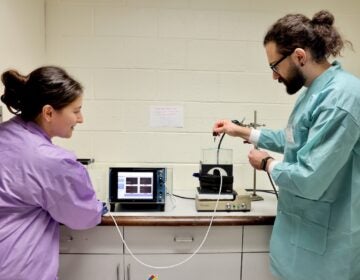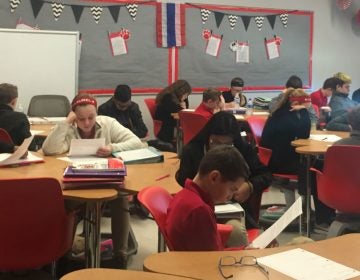For these Delaware students, robotics is ‘getting them to see the future’
Walking through Dickinson High School, one can't help but notice the two fluorescent yellow mechanical creatures.
Listen 3:17Walking through Dickinson High School, one can’t help but notice the two fluorescent yellow mechanical creatures.
They are FANUC Robots — two high-speed machines designed for an increasingly automated present and future.
Welcome to Dickinson’s Robotics Laboratory. It’s an incubator where kids learn and utilize engineering and software skills to work with Lego and Erector Set-like creations they design and build.
“We like to call this room the fish tank,’’ said Dickinson junior Jeremy Nolan, referring to the big windows allowing those passing by to see the robotics classroom. “It’s really a magnet for our school because our things are more engineering and robotics oriented than other schools.”
Dickinson’s eight-year-old robotics program continues attracting — and redirecting — kids like Nolan to the traditional public school near Pike Creek.
“Robotics has always been something I’m more interested in, because I enjoy the technology and the building aspect of things and I figured it would be a great path into computer programming,’’ Nolan said. “Because I was going to pursue computer science, but I decided later on in the program to switch to a more robotics field.”
An outgrowth of the school’s STEM program, Dickinson began teaching a robotics course in 2010. While a handful of other Delaware schools have robotics clubs, Dickinson is the only one with a formal curriculum.
Only a handful of kids enrolled at Dickinson the first year, but now about 100 of Dickinson’s 600 kids take a robotics class.
Robotics ‘all-inclusive’ for STEM students
Teacher Shawn Bowser said robotics is a field that synthesizes knowledge from a handful of critical academic disciplines.
“They take robotics to help them with other things. Like auto mechanics or engineering or architecture,” Bowser said. “And that’s the nice thing about robotics. Robotics is all-inclusive. It covers the science, the math and engineering and the computer programming all in one nice neat little package.”
The courses teaches kids the basics and some advanced skills needed to design, build, operate and repair robots for use in the home, industry and even outer space.
“I love getting the kids involved, getting them thinking,’’ Bowser said. “Getting them to see the future. It’s not just about a program here. It’s about their future now. It’s about their career. It’s about going to college.”

Nolan’s success in robotics, where his teams have won state competitions and competed in national ones, has helped earn him a partial scholarship at work Capital Technology University in Maryland.
When WHYY recently visited Dickinson, Nolan and classmate Ian Shotwell were practicing with their robot for an upcoming competition.
They tweaked their machine and fine-tuned the programming instructions, specifying when to stop, pivot, turn or lift. They run the robot with what resembles a video-game controller. Then they practiced moving around a square playing field and picking up bases, dropping them onto cones and then depositing them over a barrier into a corner.
Their robot has a motor attached to each wheel. And instead of using the customary claw to grab the cones, they settled on a spindle-like catcher featuring rubber bands. A lot of the exercise was trial and error, then more tweaking.
“We decided to take one claw that that was more precision oriented because our robot works better with speed so instead of taking a traditionally claw that picks things up, we have a spindle claw which … you can just drop on a cone and pick it up.”
But not everybody in the class enters the competitions, or is looking to study robotics in college. Junior Azaria Whittaker aspires to be a psychologist.
She was working with Lego pieces and a list of design specs to build a telescope that can take a picture of a starburst in space. Then she had to program the device.
“I came here in the middle of ninth grade and then I started taking this class and it seemed a lot more better than a lot of the other career pathways they had,’’ she said.

“It’s really good math-wise, and then also I’m not really good at building stuff so it’s really helping me to be more, I don’t know how to explain it, like more open to building a lot of other things. ‘Cause usually I’d would be like, ‘No, I can’t do that. I don’t know what that is.’”
Oh, and those big yellow robots?
One is a pneumatic arm that can be used in assembly line work. There is a pick and sorter that can do high-speed jobs like sort pills or even decorate cakes.
Bowser will begin training students with those high-tech instruments next year.
Beyond spurring kids to a career in robotics, the bottom line for Dickinson is that the program has helped attract students.
That’s no small achievement in an era when like so many schools Dickinson’s enrollment has declined as students have gravitated to charter and themed magnet schools.
“For Dickinson I think this means the world,’’ Bowser said. “We’re still slowly transitioning into what our school is really meant to be … This is definitely preparing you for the future.”
WHYY is your source for fact-based, in-depth journalism and information. As a nonprofit organization, we rely on financial support from readers like you. Please give today.





